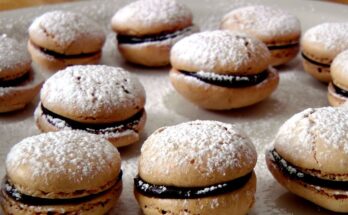Cauliflower Recipe: If you’re looking for a simple, healthy, and delicious dish that’s easy to whip up and packs a nutritional punch, you’re in the right place. Cauliflower is one of those vegetables that can easily become a weeknight hero. Whether you’re new to cooking or a seasoned pro, this step-by-step cauliflower recipe guide will walk you through every stage to help you create the perfect dish.
Let’s dig into the creamy, crispy, or spicy potential of this humble veggie.
Introduction to Cooking with Cauliflower
Cauliflower has come a long way from being just a boiled side dish your grandma used to serve. Nowadays, it’s roasted, riced, mashed, grilled, and even turned into pizza crusts. But why is cauliflower having such a moment? Because it’s insanely versatile, nutritious, and acts like a blank canvas for flavors.
Benefits of Cauliflower
Packed with fiber, vitamin C, and antioxidants, cauliflower is a powerhouse ingredient. It supports digestion, strengthens the immune system, and is low in carbs—perfect for anyone watching their weight or cutting back on starches. Plus, it’s naturally gluten-free and fits into vegan, keto, paleo, and vegetarian diets.
Why It’s a Versatile Ingredient
Its mild flavor and firm texture make it adaptable to nearly every cooking style. Want something hearty and filling? Roast it with olive oil and garlic. Craving a comfort dish? Bake it with a cheese topping. Looking for a low-carb rice or mash replacement? Blend or grate it down. With just a few pantry staples and a little creativity, cauliflower can become anything you need it to be.
Ingredients You’ll Need
Before we jump into the cooking process, let’s gather the essentials. Most of these items are probably already in your kitchen!
Fresh Produce
- 1 medium head of cauliflower (about 2 pounds)
- 2 cloves of garlic (optional but recommended)
- 1 small onion (optional, for flavor)
Pantry Essentials
- Olive oil or butter (for cooking)
- Salt and black pepper (to taste)
- Paprika or turmeric (for color and mild spice)
- Cumin or coriander (optional for deeper flavor)
Optional Add-ons for Flavor
- Grated Parmesan cheese or vegan cheese
- Fresh herbs like parsley, thyme, or cilantro
- Red chili flakes for a kick
- Lemon juice for brightness
- Soy sauce or tamari for an umami hit (especially if you’re sautéing)
These ingredients can be swapped or added based on the cooking method you choose and your flavor preferences. Whether you’re roasting or boiling, you can modify it your way.
Tools and Equipment Required
No fancy gear is necessary here, but a few kitchen basics will make your cooking process smoother and faster.
Basic Kitchen Tools
- Sharp knife and cutting board
- Large mixing bowl
- Measuring spoons
- Oven tray or skillet
- Spatula or spoon for stirring
Optional Tools for Convenience
- Food processor (if making cauliflower rice or mash)
- Steamer basket (for steaming)
- Baking parchment or foil (for roasting)
You don’t need to be a Michelin chef to make this work. A good knife, a stove or oven, and a little attention will go a long way.
Step-by-Step Cauliflower Recipe
Now, let’s roll up our sleeves. Whether you’re aiming for crispy roasted cauliflower or tender florets to add to your curry, here’s how to get it right every time.
Step 1 – Wash and Prep the Cauliflower
Start by removing the green leaves and cutting off the stem. Then rinse the cauliflower under cold water. Dry it thoroughly with a towel—especially if you’re roasting it. Moisture will create steam, which ruins crispiness.
Use a small knife to cut the cauliflower into bite-sized florets. Try to keep them similar in size so they cook evenly. If you’re planning to mash or rice it, chop it smaller or pulse it in a processor.
At this point, you can also prep your seasoning. Mix olive oil with salt, pepper, and your chosen spices in a bowl.
Step 2 – Cut into Florets
Now that your cauliflower is clean and dry, it’s time to break it down into florets. Think of florets as mini trees—that’s exactly what you’re going for here. Use a sharp knife to cut the cauliflower head in half, then cut out the thick core. Once the core is removed, the florets will naturally fall apart or become easier to separate.
Aim for florets that are about the same size so they cook at the same rate. If they’re too big, they’ll take longer to get tender or crisp up. If you’re ricing it, cut it into smaller chunks first to make blending or grating easier.
This part might take a few minutes, but it’s the foundation of your recipe. A well-cut cauliflower means more even cooking and better texture.
Step 3 – Choose Your Cooking Method
This is where you get to have some fun. Depending on your mood, time, and taste buds, you can go with different cooking styles:
Roasting (Best for Flavor and Texture)
Toss the florets with olive oil and seasonings, then spread them out on a baking sheet. Roast in a preheated oven at 425°F (220°C) for 25-30 minutes, flipping halfway through. They should come out golden, crispy on the edges, and tender inside.
Boiling or Steaming (Quick and Soft Texture)
Bring water to a boil, add the florets, and cook for about 5-7 minutes. Drain and use in salads or mash them like potatoes. For steaming, place florets in a basket over boiling water, cover, and steam for 6-8 minutes.
Sautéing (Fast and Flavorful)
Heat oil or butter in a pan over medium heat. Add your cauliflower with spices, and sauté for 10-12 minutes until golden. Stir frequently for even cooking.
Air Frying (Crispy and Low Oil)
Air fry seasoned florets at 400°F (200°C) for about 15 minutes, shaking the basket halfway. They’ll be super crispy without needing much oil.
No matter which method you pick, cauliflower is very forgiving. Just don’t overcrowd the pan or sheet if you want that perfect texture.
Step 4 – Seasoning and Spices
Here’s where your cauliflower transforms from plain to plate-licking delicious. Seasoning is everything.
Start with the basics: salt and pepper. Then choose your flavor profile:
- Spicy: Chili powder, cayenne, red pepper flakes
- Savory: Garlic powder, onion powder, smoked paprika
- Herby: Dried thyme, rosemary, parsley
- Tangy: Lemon zest, balsamic vinegar
- Asian-inspired: Soy sauce, ginger, sesame oil
- Indian-style: Turmeric, garam masala, cumin
Toss your florets in your chosen blend along with olive oil before cooking. You can even add cheese (like grated Parmesan) for the last few minutes of roasting for a crusty, cheesy finish.
Pro tip: always taste and adjust. Cauliflower absorbs flavors well, but you don’t want it overpowered. A squeeze of lemon or a drizzle of sauce after cooking can also boost the taste.
Step 5 – Cooking Time and Techniques
Cooking time varies depending on your chosen method and floret size. Here’s a cheat sheet:
| Method | Temp | Time |
|---|---|---|
| Roasting | 425°F/220°C | 25–30 mins |
| Boiling | Boiling point | 5–7 mins |
| Steaming | N/A | 6–8 mins |
| Sautéing | Medium heat | 10–12 mins |
| Air Frying | 400°F/200°C | 12–15 mins |
Tips for perfect results:
- Don’t overcrowd the pan—space = crispiness.
- Flip or stir halfway through cooking.
- Add delicate seasonings like fresh herbs or cheese toward the end.
- Use parchment paper for easy cleanup when roasting.
Cook until golden and fork-tender. Taste a floret to check. It should be slightly crispy on the outside, tender on the inside, and full of flavor.
Serving Suggestions
Once your cauliflower is cooked and seasoned, it’s time to plate it up. And trust me, the possibilities are endless.
As a Side Dish
Roasted cauliflower makes a killer side dish for grilled meats, baked fish, or even pasta. Pair it with chicken breast or steak for a hearty, healthy dinner. Add a dipping sauce like garlic aioli, tahini, or spicy mayo for bonus points.
As the Main Star
Want to keep it vegetarian or low-carb? Turn your cauliflower into the main attraction. Serve it over quinoa, rice, or couscous with a drizzle of sauce and fresh herbs. You can also stuff it in a wrap with some hummus and greens, or toss it into a grain bowl.
For Salads or Meal Prep
Cold roasted or sautéed cauliflower works great in salads. Add it to a bowl of arugula, cherry tomatoes, cucumbers, and chickpeas with a light vinaigrette. It keeps well in the fridge and makes an awesome lunch option.
Tips for the Best Cauliflower Dish
Want to make your cauliflower dish go from good to unforgettable? Here are some pro tips that’ll take your cooking game to the next level.
1. Don’t Skip the Drying Step
One of the most common mistakes people make is tossing wet cauliflower into the oven or pan. Moisture equals steam, and steam equals soggy cauliflower. Always pat your florets dry with a clean towel before seasoning and cooking. Dry florets = crispy, caramelized bites.
2. Season Liberally (But Smartly)
Cauliflower’s neutral flavor means it needs a little help to shine. Don’t be shy with your spices, but know when to hold back. If you’re roasting with cheese, for example, ease up on the salt since cheese adds plenty of it.
3. Mix and Match Textures
Pair roasted cauliflower with something creamy—like a yogurt sauce, tahini drizzle, or even a runny egg. The contrast makes for a more interesting dish. You can also combine roasted and sautéed cauliflower for different textures in one meal.
4. Don’t Be Afraid of High Heat
Cranking up your oven to 425°F (220°C) gives cauliflower that irresistible golden crust. It may feel a little high, but trust the process. Just keep an eye on it, especially after the 20-minute mark.
5. Add a Pop of Freshness
A squeeze of lemon juice, a sprinkle of chopped herbs, or a spoonful of pesto right before serving can wake up the entire dish. These finishing touches make all the difference.
6. Taste as You Go
It might seem simple, but tasting at every step helps you adjust seasoning and avoid bland results. Cooking is part art, part science—use your senses to guide you.
Storage and Reheating Tips
So, you’ve nailed your cauliflower dish, but now you’ve got leftovers. No problem! Cauliflower stores and reheats surprisingly well with the right tricks.
Storing Leftovers
- In the Fridge: Store cooked cauliflower in an airtight container. It stays fresh for 3–4 days.
- In the Freezer: Cauliflower can be frozen after cooking, especially if roasted or sautéed. Let it cool completely, spread on a tray to freeze individually, then transfer to a zip-top bag.
Be aware that frozen cauliflower can become softer when reheated, so it’s best used in soups, stews, or purees after thawing.
Reheating Without Losing Flavor
- Oven: Preheat to 375°F and reheat on a baking sheet for 8–10 minutes. This brings back some of the crisp.
- Stovetop: Heat a little oil or butter in a pan and sauté on medium heat until warmed through.
- Microwave: Works in a pinch, but the texture might suffer. Use a microwave-safe dish, cover with a paper towel, and heat in 30-second bursts.
For best results, avoid reheating multiple times. Only warm up what you plan to eat.
Variations to Try
Cauliflower isn’t just a side dish—it can become an entire culinary experience. Here are a few creative twists you can try once you’ve mastered the basics.
1. Spicy Buffalo Cauliflower
Toss roasted or air-fried florets in a mix of hot sauce and melted butter. Serve with ranch or blue cheese dressing for that classic buffalo wing flavor without the meat.
2. Cauliflower Curry
Sauté cauliflower with onions, garlic, tomatoes, and Indian spices like turmeric, garam masala, and cumin. Add coconut milk for creaminess and simmer until tender. Serve over rice or with naan.
3. Cheesy Baked Cauliflower
After roasting or boiling the florets, place them in a baking dish, sprinkle with shredded cheese, and bake until bubbly and golden. You can also add breadcrumbs on top for a crispy finish.
4. Cauliflower Tacos
Roast florets with taco seasoning, then stuff into tortillas with avocado, cabbage slaw, and a lime crema. It’s a plant-based taco night done right.
5. Cauliflower Stir-Fry
Toss cauliflower with soy sauce, sesame oil, garlic, and ginger in a hot pan. Add bell peppers, snap peas, or any veggie you like for a quick, colorful stir-fry.
Health Benefits of Cauliflower
You’ve probably heard cauliflower is healthy, but let’s break it down. This veggie is more than just low-carb—it’s genuinely packed with nutrients and offers real health perks.
Nutritional Highlights
- Low in calories: Just 25 calories per cup.
- Rich in fiber: Great for digestion and keeping you full.
- Loaded with Vitamin C: Supports immunity and skin health.
- Contains antioxidants: Helps reduce inflammation and oxidative stress.
- High in choline: Important for brain health and metabolism.
Perfect for Special Diets
Whether you’re keto, paleo, vegan, or gluten-free, cauliflower fits the bill. It’s naturally low in carbs and sugar, making it ideal for those watching their blood sugar levels or trying to lose weight.
Cauliflower can easily replace high-carb ingredients—think mashed potatoes, pizza crust, or rice—with none of the guilt. It’s one of those veggies that truly punches above its weight when it comes to health benefits.
FAQs about Cauliflower Recipe
1. Can I roast cauliflower without oil?
Yes, you can! Use a light spray of water or broth and roast at a high temperature. The texture won’t be as crispy, but it’s still delicious and healthy.
2. How do I keep cauliflower from getting soggy?
Pat it dry before cooking! Moisture is the enemy of crispiness. Also, don’t overcrowd the pan when roasting—space is key for that golden brown finish.
3. Can I freeze cooked cauliflower?
Absolutely. Let it cool, store it in an airtight container, and freeze for up to 3 months. Reheat in the oven or air fryer to revive its texture.
4. What spices go well with cauliflower?
Cauliflower is like a flavor sponge. Try garlic powder, paprika, cumin, turmeric, curry powder, or Italian herbs. Go bold—it can handle it.
5. Is cauliflower keto-friendly?
Totally! Cauliflower is low in carbs and high in fiber, making it a favorite for keto and low-carb diets. Great for mash, rice, or even pizza crusts.
Conclusion
Cauliflower is the chameleon of the vegetable world—mild in flavor, bold in potential. Whether you roast it, boil it, fry it, or mash it, there’s no wrong way to enjoy this versatile veggie. It’s easy to cook, loaded with nutrients, and can be tailored to suit any taste preference or diet.
The next time you’re staring into your fridge wondering what to make, let cauliflower be your blank canvas. Add your favorite seasonings, pick a cooking method, and serve it up however you like. From spicy buffalo bites to creamy curry, the options are endless.



